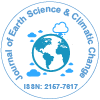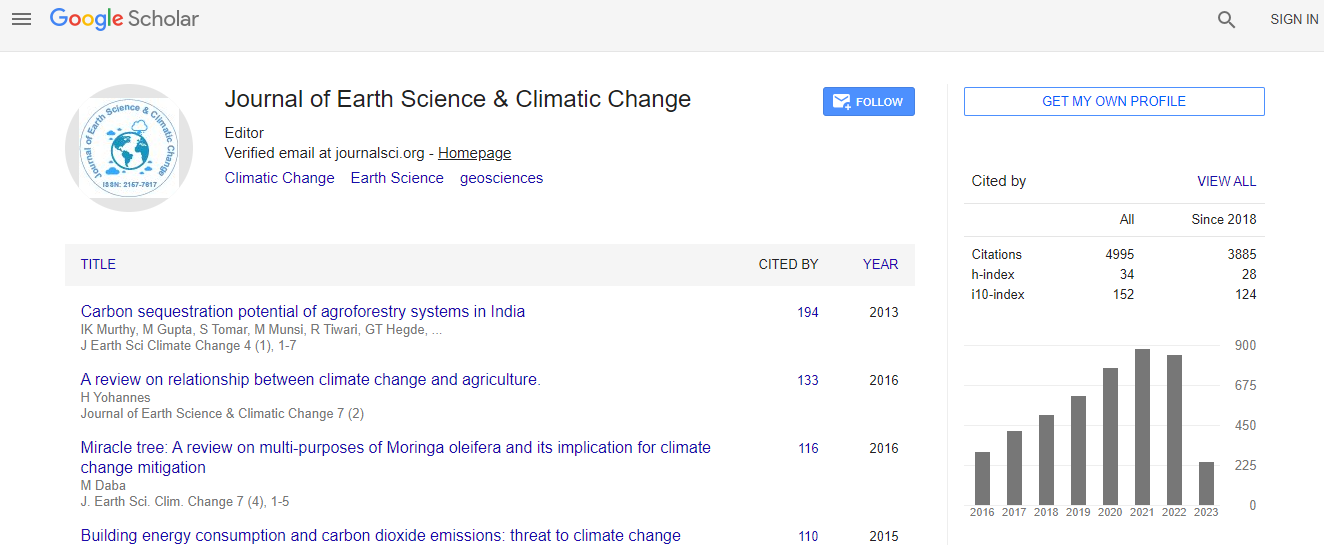Our Group organises 3000+ Global Conferenceseries Events every year across USA, Europe & Asia with support from 1000 more scientific Societies and Publishes 700+ Open Access Journals which contains over 50000 eminent personalities, reputed scientists as editorial board members.
Open Access Journals gaining more Readers and Citations
700 Journals and 15,000,000 Readers Each Journal is getting 25,000+ Readers
Google Scholar citation report
Citations : 5125
Journal of Earth Science & Climatic Change received 5125 citations as per Google Scholar report
Journal of Earth Science & Climatic Change peer review process verified at publons
Indexed In
- CAS Source Index (CASSI)
- Index Copernicus
- Google Scholar
- Sherpa Romeo
- Online Access to Research in the Environment (OARE)
- Open J Gate
- Genamics JournalSeek
- JournalTOCs
- Ulrich's Periodicals Directory
- Access to Global Online Research in Agriculture (AGORA)
- Centre for Agriculture and Biosciences International (CABI)
- RefSeek
- Hamdard University
- EBSCO A-Z
- OCLC- WorldCat
- Proquest Summons
- SWB online catalog
- Publons
- Euro Pub
- ICMJE
Useful Links
Recommended Journals
Related Subjects
Share This Page
In Association with

Increasing losses caused by extreme weather events: What are the drivers and what is the role of climate change?
3rd World Congress on Climate Change and Global Warming
Peter Hoeppe
Munich Re, Germany
Keynote: J Earth Sci Clim Change
Abstract
Losses caused by natural disasters are a major factor influencing the balance sheet of insurers, especially reinsurers. Such events have a high potential of creating extreme accumulation losses. This is why the insurance industry has built up a lot of expertise in analyses and assess-ment of trends of losses caused by natural perils. Such losses have increased tremendously worldwide in the last decades. In order to detect the drivers of this trend the losses have to be adjusted for changes in exposed values. Munich Re just recently has developed a very sophisticated method for such a normalization of losses. After this normalization a still residual loss trend can be either driven by changes in the vulnerability of assets or on the hazard side. The results of such analyses with data of the Munich Re Nat Cat SERVICE database clearly show that in the last decades the main drivers of the loss trend have been changes in the exposure of values, i.e., growth of population and wealth in affected regions. Also a shift of population into more hazardous regions, especially to the coasts is increasing the losses. On the other side a clear signal of prevention measures, e.g., investment into flood protection, already can be detected in decreasing normalized losses caused by river floods, even though the number of intense precipitation events has increased. For thunderstorm related loss events the number of events as well as the normalized losses has increased significantly in North America and Europe. There is a suggestion that these increases are driven by an increase in the humidity of the lower atmosphere and thus, that this is a secondary effect of climate change. As global warming will continue in the coming decades, its contribution to increasing natural catastrophe losses will become more prominent, a projection also given by the 5th assessment report of the Intergovernmental Panel on Climate Change.Biography
Peter Hoeppe is the Chairman of the Munich Climate Insurance Initiative, which he founded in 2005 and had been appointed as Climate Change Advisor of the Bavarian State Government. He has completed his Masters and PhD in Meteorology and Human Biology.

 Spanish
Spanish  Chinese
Chinese  Russian
Russian  German
German  French
French  Japanese
Japanese  Portuguese
Portuguese  Hindi
Hindi 
